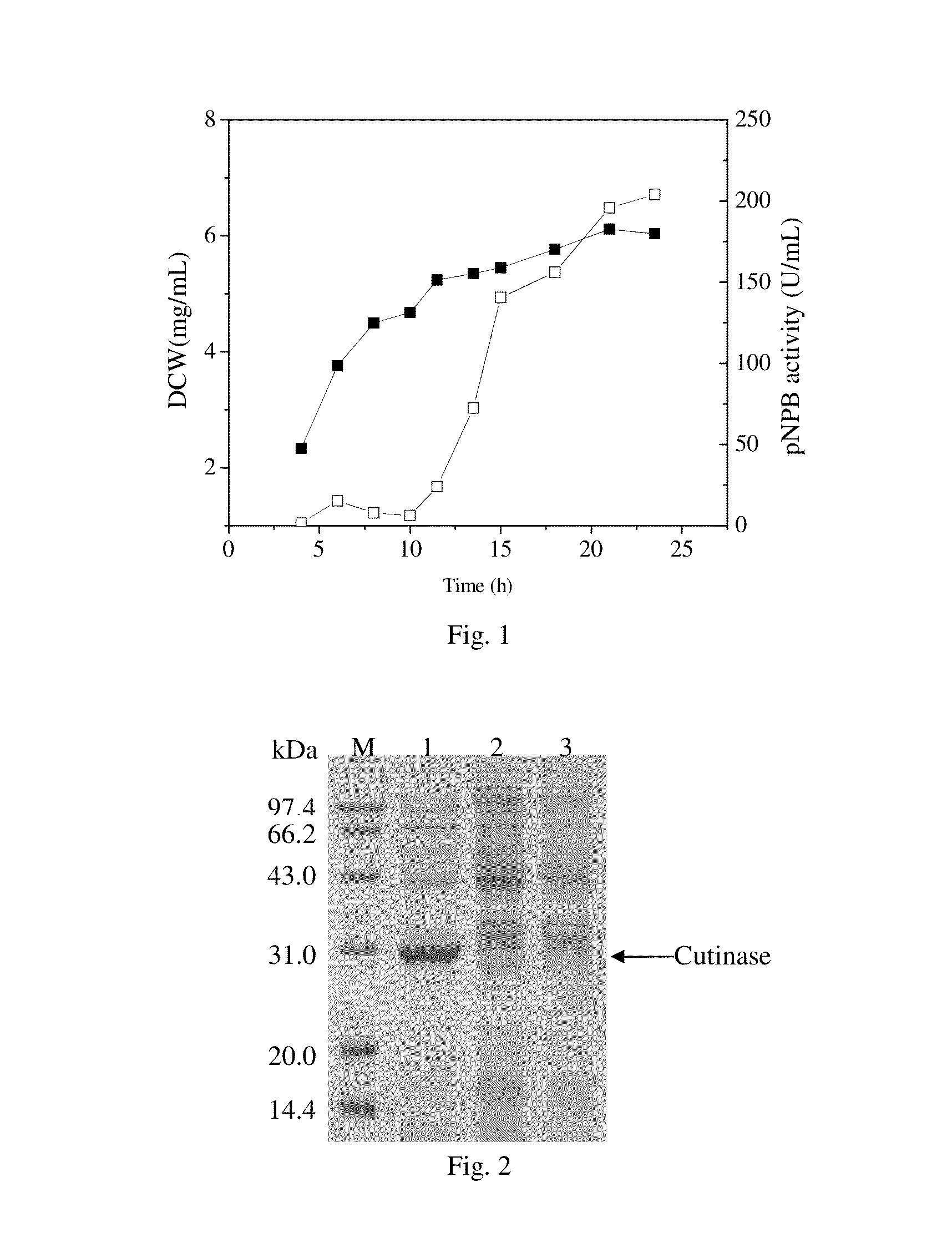Method for enhancing extracellular secretion of recombinant proteins in Escherichia coli by co-expressing Thermobifida fusca cutinase
a technology of escherichia coli and recombinant proteins, which is applied in the field of enhancing extracellular secretion of recombinant proteins in escherichia coli, can solve the problems of increasing membrane permeability and coli is usually considered to be a poor protein secretor
- Summary
- Abstract
- Description
- Claims
- Application Information
AI Technical Summary
Benefits of technology
Problems solved by technology
Method used
Image
Examples
example 1
Construction of Tfu—0883 / pET-20b(+)NS Plasmid
[0033]Construction of Tfu—0883 / pET-20b(+)NS plasmid comprised the following steps:
[0034](1) The gene encoding a mature cutinase (124-906 bp in the gene sequence of NCBI accession number AAZ54921) was amplified from Tfu—0883 / pET-20b (+), which contained the full length cutinase gene of NCBI accession number AAZ54921 inserted in Nco I and EcoR I restriction enzyme sites of plasmid pET-20b), by polymerase chain reaction using the primers P1 (SEQ ID No: 1) and P2 (SEQ ID No: 2) in 50 μL PCR system. SEQ ID No. 1: gTAATCCATATggCCAACCCCTACgAgCgC (With restriction enzyme Nde I cutting site). SEQ ID No. 2: AgAgAATTCgggAACgggCAggTggAgCg (With restriction enzyme EcoR I cutting site). The PCR process was as follows: denaturation at 94° C. for 4 min, cyclical reaction for 30 times (98° C. for 10 s, 60° C. for 5 s, 72° C. for 1 min), elongation at 72° C. for 10 min, and finally being kept at 4° C. After gel purification, the PCR products were ligated i...
example 2
Expression of Tfu—0883 / pET-20b(+)NS by E. coli BL21 (DE3)
[0036]Expression of Tfu—0883 / pET-20b(+)NS by E. coli BL21 (DE3) comprised the following steps:
[0037]After transformation, E. coli BL21 (DE3) containing Tfu—0883 / pET-20b (+)NS was cultivated on LB-Amp agar plate for overnight at 37° C. The single colonies were transferred into liquid LB-Amp and cultivated to later logarithmic phase. The culture broth was inoculated into liquid TB (Containing 100 μg / mL Amp) with 5% inoculation percent and grown at 37° C. for 2 h. Lactose was added to a final concentration of 5 g / L and the temperature was lowered to 25° C. for induction.
[0038]As shown in FIG. 1, during cultivation in the shake flask, the cutinase activity in the culture medium increased rapidly from 12 h of post induction and reached a maximum of 204.8 U / mL at 24 h. However, the cutinase activity in the cytoplasm was only 10.1 U / mL at the same time, which meant the cutinase without a signal peptide was almost completely “secreted...
example 3
3 L Bioreactor for Production of Cutinase
[0039]The extracellular “secretion” efficiency of the above E. coli BL21 (DE3) harboring cutinase was further explored in 3 L fermentor. Exponential fed-batch culture strategy at a controlled speed was carried out to produce cutinase using recombinant E. coli BL21 (DE3) high cell-density culture.
[0040]The 3 L bioreactor for production of cutinase comprised the following steps:
[0041](1) During fermentation, when the initial carbon resource (Glycerol) worked out at 6 h, the fresh substrate was fed. The feed was exponentially increased and coincided with specific growth rate (μ=0.25 h−1).
[0042](2) When the OD600 of culture broth reached 50, lactose was added for induction at a flow rate of 0.6 g / L / hr.
[0043]As shown in FIG. 3, the cutinase activity in the culture medium increased rapidly from 9 h of post induction and reached a maximum of 1063 U / mL that was 5.2 times higher than in the shake flask cultivation. In addition, the productivity 44.2 U...
PUM
| Property | Measurement | Unit |
|---|---|---|
| temperature | aaaaa | aaaaa |
| temperature | aaaaa | aaaaa |
| concentration | aaaaa | aaaaa |
Abstract
Description
Claims
Application Information
 Login to View More
Login to View More - R&D
- Intellectual Property
- Life Sciences
- Materials
- Tech Scout
- Unparalleled Data Quality
- Higher Quality Content
- 60% Fewer Hallucinations
Browse by: Latest US Patents, China's latest patents, Technical Efficacy Thesaurus, Application Domain, Technology Topic, Popular Technical Reports.
© 2025 PatSnap. All rights reserved.Legal|Privacy policy|Modern Slavery Act Transparency Statement|Sitemap|About US| Contact US: help@patsnap.com



